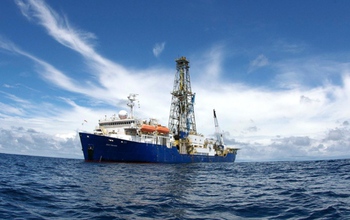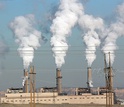Hola amigos: A VUELO DE UN QUINDE EL BLOG.,hemos recibido información de la Fundación Nacional de Ciencias de Los Estados Unidos, sobre la utilización y medición del carbono durante los últimos 66 millones de años.
NSF, nos dice: "Las primeras mediciones del clima de la Tierra utilizando termómetros y otros instrumentos comienzan en la década de 1850.
Para buscar más atrás en el tiempo, los científicos investigan las burbujas de aire atrapadas en los núcleos de hielo, ampliar el alcance de los registros climáticos de casi un millón de años. Pero para estudiar la historia de la Tierra durante millones de años, los investigadores examinan las firmas químicas y biológicas en los sedimentos de aguas profundas.
Una nueva investigación publicada hoy en la revista Nature Geoscience por geociencias Richard Zeebe de la Universidad de Hawai en Manoa y sus colegas analiza los cambios en la temperatura y el dióxido de carbono atmosférico (CO2) de la Tierra desde el fin de la era de los dinosaurios. La evidencia está en los núcleos de sedimentos recuperados de debajo del lecho marino por los geólogos que trabajan a bordo del buque de perforación JOIDES Resolution océano.
Para buscar más atrás en el tiempo, los científicos investigan las burbujas de aire atrapadas en los núcleos de hielo, ampliar el alcance de los registros climáticos de casi un millón de años. Pero para estudiar la historia de la Tierra durante millones de años, los investigadores examinan las firmas químicas y biológicas en los sedimentos de aguas profundas.
Una nueva investigación publicada hoy en la revista Nature Geoscience por geociencias Richard Zeebe de la Universidad de Hawai en Manoa y sus colegas analiza los cambios en la temperatura y el dióxido de carbono atmosférico (CO2) de la Tierra desde el fin de la era de los dinosaurios. La evidencia está en los núcleos de sedimentos recuperados de debajo del lecho marino por los geólogos que trabajan a bordo del buque de perforación JOIDES Resolution océano.
More information....
Humans responsible for carbon release 10 times faster than any event since age of dinosaurs
 Credit and Larger Version |
The earliest measurements of Earth's climate using thermometers and other tools start in the 1850s.
To look further back in time, scientists investigate air bubbles trapped in ice cores, expanding the scope of climate records to nearly a million years. But to study Earth's history over millions of years, researchers examine the chemical and biological signatures in deep-sea sediments.
New research published today in the journal Nature Geoscience by geoscientist Richard Zeebe of the University of Hawai'i at Manoa and colleagues looks at changes in Earth's temperature and atmospheric carbon dioxide (CO2) since the end of the age of the dinosaurs. The evidence is in sediment cores retrieved from beneath the seafloor by geologists working aboard the ocean drillship JOIDES Resolution.
"In studying one of the most dramatic episodes of global change since the dinosaurs, the researchers show that we are currently in uncharted territory in the rate carbon is being released into the atmosphere and oceans," said Candace Major, program director in the National Science Foundation (NSF) Division of Ocean Sciences, which funded the research.
The findings suggest that humans are responsible for releasing carbon about 10 times faster than during any time in the past 66 million years.
The research team developed a new approach and was able to determine the duration of the onset of an important past climate event, the Paleocene-Eocene Thermal Maximum (PETM), 56 million years ago.
"As far as we know, the PETM had the largest carbon release during the past 66 million years," Zeebe said.
Zeebe and co-authors Andy Ridgwell, of the University of Bristol and University of California, and James Zachos, of the University of California, combined analyses of chemical properties of sediment cores dating back to the PETM with numerical simulations of Earth's climate and carbon cycle.
The new method allowed them to extract rates of change from a sediment record.
Applied to the PETM, they calculated how fast the carbon was released, how fast Earth's surface warmed, and what constrained the time scale of the onset, which was across 4,000 years.
The rate of carbon release during the PETM was much smaller than the current input of carbon to the atmosphere from human activities.
Carbon release rates from human sources reached a record high in 2014 of about 37 billion metric tons of CO2. The researchers estimated that the maximum sustained carbon release rate during the PETM was less than four billion metric tons of CO2 per year -- about one-tenth the current rate.
"Because our carbon release rate is unprecedented over such a long time period in Earth's history, it also means that we have effectively entered a 'no-analogue' state," said Zeebe. "This represents a big challenge for projecting future climate change because we have no good comparison from the past."
Whereas large climate transitions in the past may have been relatively smooth, there is no guarantee for the future, the scientists said. The climate system is non-linear, which means that its response to inputs, such as CO2 emissions, is a complex process involving multiple components.
"If you kick a system very fast, it usually responds differently than if you nudge it slowly but steadily," Zeebe said. "It is likely that future disruptions of ecosystems will exceed the relatively limited extinctions observed at the PETM."
The PETM suggests that the consequences of our massive burning of fossil fuels will have much longer-lasting effects, said Zeebe.
"Everyone is focused on what happens by 2100, but that's only two generations from today," he said. "It's very clear that over a longer time scale there will be much bigger changes."
The scientists are continuing their work on the PETM to study other aspects of the event -- for example, determining how severe ocean acidification was during that time and what effect it had on calcifying organisms in the ocean. The results will provide insights about what to expect in the future as Earth's climate likely continues to warm and oceans keep acidifying.
-NSF-
Media Contacts Cheryl Dybas, NSF, (703) 292-7734, cdybas@nsf.gov
Marcie Grabowski, University of Hawaii - Manoa, (808) 956-3151, mworkman@hawaii.edu
The National Science Foundation (NSF) is an independent federal agency that supports fundamental research and education across all fields of science and engineering. In fiscal year (FY) 2016, its budget is $7.5 billion. NSF funds reach all 50 states through grants to nearly 2,000 colleges, universities and other institutions. Each year, NSF receives more than 48,000 competitive proposals for funding and makes about 12,000 new funding awards. NSF also awards about $626 million in professional and service contracts yearly.
Useful NSF Web Sites:
NSF Home Page:
http://www.nsf.gov
NSF News:
http://www.nsf.gov/news/
For the News Media:
http://www.nsf.gov/news/newsroom.jsp
Science and Engineering Statistics:
http://www.nsf.gov/statistics/
Awards Searches:
http://www.nsf.gov/awardsearch/

Sediment cores from beneath the ocean floor hold clues to Earth's carbon dioxide levels over time.
Credit and Larger Version

Carbon dioxide levels are increasing faster than at any time since the end of the dinosaurs.
Credit and Larger Version

The scientists are continuing their work to determine ocean acidification levels during the PETM.
Credit and Larger Version

Today the common sea fan is one of the many species affected by ocean acidification.
Credit and Larger Versión
The National Science Foundation (NSF)
Guillermo Gonzalo Sánchez Achutegui
ayabaca@gmail.com
ayabaca@hotmail.com
ayabaca@yahoo.com
Inscríbete en el Foro del blog y participa : A Vuelo De Un Quinde - El Foro!

No hay comentarios:
Publicar un comentario